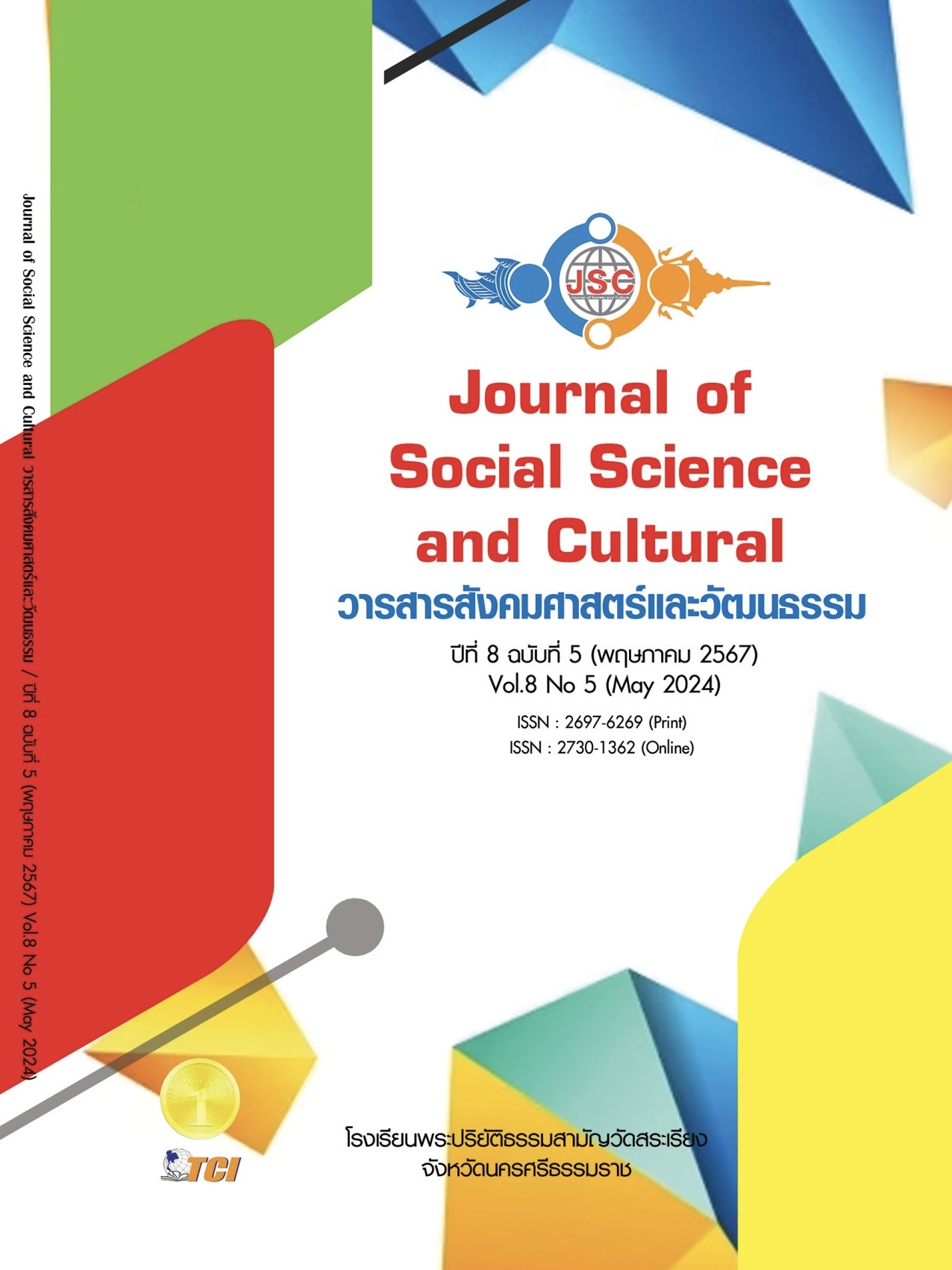STUDY OF NEEDS AND GUIDELINES FOR DEVELOPING INTEGRATED TEACHING AND LEARNING FORMATS TO PROMOTE LEARNING IN PERFORMING DANCE SKILLS
Main Article Content
Abstract
This research article has the objective of studying the need for organizing teaching and learning in a blended format. To promote learning in performing dance skills For higher education students Bunditpatanasilpa Institute The group of informants was teachers and first- and second-year undergraduate students in the field of dance studies. From all colleges of performing arts Under the Bunditpatanasilpa Institute, a total of 389 people. The research instrument was a questionnaire on the current conditions and needs for organizing blended teaching and learning. To promote learning in performing dance skills Tertiary level Bunditpatanasilpa Institute. Statistics used in data analysis include percentage, mean, and standard deviation. and the Priority Need Index (PNI) between current conditions and needs. The research results found that The Priority Needs Index (PNI) from the questionnaire on the current conditions and needs for organizing blended teaching and learning. To promote learning in performing dance skills For higher education students Bunditpatanasilpa Institute In terms of teaching and learning, media and technology, the group of teachers is that teachers produce teaching media for use in organizing practical teaching that is consistent with the curriculum (PNI = 0.16). The group of students is that teachers produce teaching media. Modern teaching provides opportunities for students to learn and review lessons by themselves in an online format (PNI = 0.08) Measurement and evaluation The group of teachers is that students have confidence in evaluating the results of online teaching (PNI = 0.16). The group of students is that teachers use a variety of measurement and evaluation tools. and is appropriate to the content (PNI = 0.09).
Article Details
References
กิตติชัย สุธาสิโนบล. (2562). หลักสูตรและการเรียนรู้แบบดิจิทัล. วารสารวิชาการศึกษาศาสตร์, 20(1), 200-211.
กีรติ คุวสานนท์. (2560). การจัดการเรียนรู้สู่วิถีผู้เรียนเป็นสิ่งสำคัญ. (พิมพ์ครั้งที่ 1). กรุงเทพมหานคร: บริษัท นัชชาวัตน์ จำกัด.
จินตวีร์ คล้ายสังข์. (2563). เอกสารประกอบการอบรมเชิงวิชาการ เรื่อง การเรียนรู้แบบผสมผสาน (Blended Learning). กรุงเทพมหานคร: ภาควิชาเทคโนโลยีและสื่อสารการศึกษา คณะครุศาสตร์ จุฬาลงกรณ์มหาวิทยาลัย.
ณัฐวรรณ เฉลิมสุข. (2563). การพัฒนารูปแบบการเรียนการสอนแบบผสมผสาน วิชาศิลปศึกษาตามแนวทางการคิดเชิงออกแบบร่วมกับการเรียนศิลปะปฏิบัติ ที่บูรณาการเครื่องมือทางปัญญา เพื่อพัฒนาความคิดสร้างสรรค์ในการสร้างผลงานศิลปะของนักเรียนมัธยามศึกษาตอนปลาย. ใน ดุษฎีนิพนธ์ปรัชญา
ดุษฎีบัณฑิต สาขาเทคโนโลยีการศึกษา. มหาวิทยาลัยราชภัฏมหาสารคาม.
บุญทิพย์ สิริธรังศรี. (2563). การจัดการเรียนการสอนออนไลน์สู่กรอบมาตรฐานวิชาชีพการสอนและสนับสนุนการเรียนรู้ระดับอุดมศึกษา. วารสารวิชาการราชวิทยาลัยจุฬาภรณ์, 2(3), 1-17.
ศุภักษร ฟองจางวาง. (2559). การศึกษาองค์ประกอบของรูปแบบการเรียนการสอนแบบผสมผสานโดยใช้ การเรียนรู้แบบร่วมมือเรื่องการเขียนโปรแกรมขั้นพื้นฐานด้วยภาษาจาวาสคริปต์สำหรับนักเรียนชั้นมัธยมศึกษาปีที่ 3. วารสารวิชาการ Veridian E-Journal, 9(3), 937-953.
สำนักงานเลขาธิการสภาการศึกษา. (2560). แผนการศึกษาแห่งชาติ พ.ศ. 2560 - 2579. (พิมพ์ครั้งที่ 2). กรุงเทพมหานคร: สำนักงานเลขาธิการสภาการศึกษา.
สิทธิโชค พรรค์พิทักษ์. (2563). การพัฒนารูปแบบการเรียนรู้แบบผสมผสานโดยใช้การเรียนรู้แบบกิจกรรมเป็นฐานที่มีพี่เลี้ยงออนไลน์สนับสนุนที่ส่งเสริมความสามารถการคิดแก้ปัญหาสำหรับนักศึกษาปริญญาตรี. ใน ดุษฎีนิพนธ์ปรัชญาดุษฎีบัณฑิต สาขาคอมพิวเตอร์ศึกษา. มหาวิทยาลัยราชภัฏ
มหาสารคาม.
สุวิทย์ เมษินทรีย์. (2556). โลกเปลี่ยน ไทยปรับ. (พิมพ์ครั้งที่ 2). กรุงเทพมหานคร: บริษัท ซีเอ็ดยูเคชั่น จำกัด (มหาชน).
สุวิมล วองวาณิช และนงลักษณ์ วิรัชชัย. (2550). แนวทางการให้คำปรึกษาวิทยานิพนธ์. (พิมพ์ครั้งที่ 2). กรุงเทพมหานคร: โรงพิมพ์แห่งจุฬามหาวิทยาลัย.
Berrett, D. & Strayer, J. (2012). How “Flipping” the classroom can improve the traditional lecture. The Education Digest, 78(1), 36-41.
Carman, J. M. (2005). Blended Learning Design: Five Keys Ingredients. Retrieved April 10 , 2021, from https://www.researchgate.net/publication/238687086_Blended_learning_design_Five_key_ingredients.
Smaldino, S. E. et al. (2012). Instructional technology and media for learning. (10th Ed.). Boston: Master's degree. pearson.


